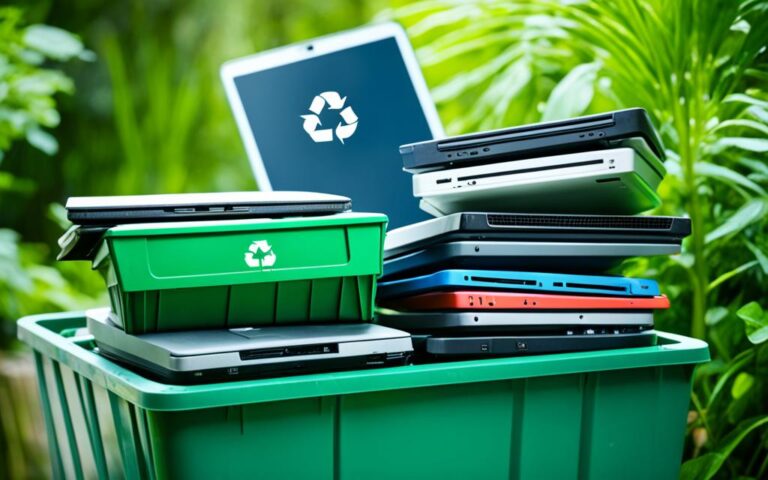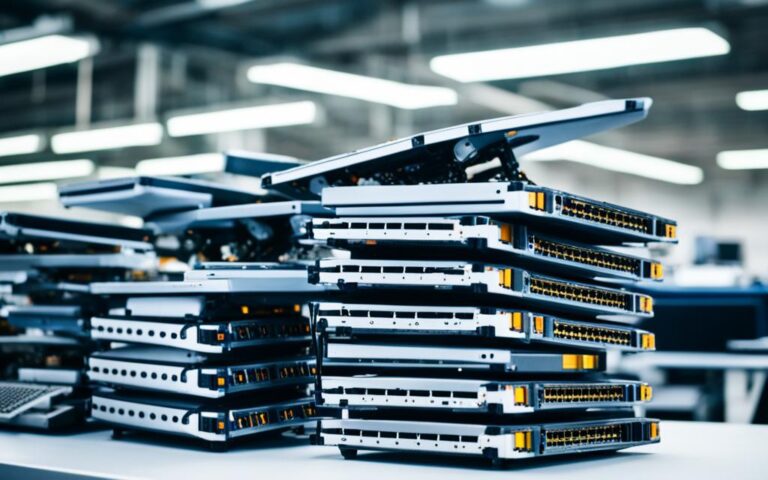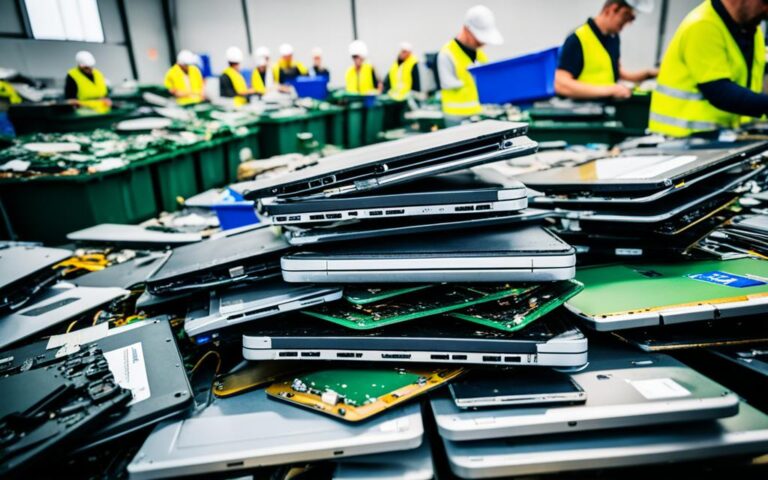The Benefits of Participating in National Laptop Recycling Day
Welcome to National Laptop Recycling Day, an annual event that promotes sustainability and responsible technology recycling in the United Kingdom. By participating in this initiative, you have the opportunity to make a positive impact on the environment and contribute to a more sustainable future. With the increasing amount of electronic waste, or e-waste, it’s essential to take action and responsibly recycle your old laptops, cell phones, and tablets.
Through National Laptop Recycling Day, you can ensure that your electronic devices are recycled properly, reducing their negative environmental impact. By recycling e-waste, valuable materials can be reclaimed, reducing the need for new raw materials and conserving important natural resources. This recycling process also helps prevent soil and water contamination caused by the toxic substances found in electronic devices.
Join us in celebrating National Laptop Recycling Day and contribute to the responsible management of e-waste in the UK. By participating, you can make a difference and support sustainability efforts. Together, let’s recycle our old technology and create a greener future.
The Environmental Impact of E-waste
E-waste recycling plays a crucial role in minimizing the negative environmental impact of electronic waste. Electronic devices, when improperly disposed of in landfills, can release toxic substances and heavy metals into the environment, leading to soil and water contamination. By recycling e-waste, we can prevent these hazardous materials from leaching into our ecosystems and protect the health of our planet.
But the benefits of e-waste recycling go beyond just preventing pollution. Electronic products are made up of valuable materials, including precious metals like gold, silver, and copper. Through the recycling process, these valuable materials can be extracted and reused, reducing the need for new raw materials. This not only conserves important natural resources but also reduces the destructive environmental impacts of mining and extraction.
Using recycled materials in the production of new electronic products also has another significant advantage. It helps to reduce greenhouse gas emissions associated with the manufacturing process. The extraction and production of raw materials, as well as the manufacturing of electronic devices, contribute to the release of greenhouse gases into the atmosphere. By using recycled materials, we can significantly reduce these emissions, contributing to the fight against climate change.
The Importance of Reusing and Refurbishing Electronic Devices
In addition to recycling, reusing and refurbishing electronic devices plays a crucial role in the management of e-waste. When discarded electronic devices are refurbished, they can be given a new lease on life and donated to individuals in need, helping to keep them out of the waste stream. Numerous organizations specialize in rebuilding old electronics, ensuring that they are still usable and functional, and then providing them to individuals who may not have access to technology otherwise.
Reusing electronic devices not only extends their lifespan but also reduces the demand for new products to be manufactured, thereby conserving valuable resources. By giving these devices a second chance, we can minimize the environmental impact caused by extracting raw materials and manufacturing new electronics. Additionally, when electronic devices reach their end-of-life stage, they can still be valuable in the scrap metal recycling industry.
“Reusing electronic devices not only extends their lifespan but also reduces the demand for new products to be manufactured, thereby conserving valuable resources.”
When e-waste ends up in scrapyards, valuable materials such as copper and other metals can be extracted and sent through the recycling process. This not only helps recover valuable resources but also reduces the need for new extraction and mining, which is often detrimental to the environment. By reusing and refurbishing electronic devices, we can make a significant impact on reducing e-waste and ensuring a more sustainable future.
The Benefits of Reusing and Refurbishing Electronic Devices:
- Reduces electronic waste in the waste stream
- Extends the lifespan of electronic devices
- Minimizes the demand for new product manufacturing
- Conserves valuable natural resources
- Supports the scrap metal recycling industry
The Impact of National Device Bank on E-waste Management
The National Device Bank plays a crucial role in responsible corporate e-waste management by providing a method of IT asset disposal that focuses on reusing electronic devices. Rather than recycling or discarding used IT equipment such as laptops, tablets, and mobiles, organizations are encouraged to donate these devices to the National Device Bank. This initiative not only helps reduce e-waste but also addresses the issue of digital inclusion by providing access to technology for individuals and community organizations who are digitally excluded.
By donating to the National Device Bank, organizations contribute to responsible corporate e-waste management. These donated devices undergo a refurbishment process and are then distributed to those in need. This not only extends the lifespan of electronic devices but also reduces the demand for new products to be manufactured, thereby conserving valuable natural resources. Through the National Device Bank, organizations can actively participate in creating a more sustainable future by adopting a circular approach to IT asset disposal.
Responsible IT Asset Disposal
Responsible IT asset disposal is essential for minimizing the environmental impact of electronic waste. By donating to the National Device Bank, organizations demonstrate their commitment to responsible e-waste management and contribute to a more sustainable society. Instead of disposing of electronic devices through recycling or landfilling, which can lead to negative environmental consequences, the National Device Bank offers a more environmentally friendly solution.
By reusing electronic devices through the National Device Bank, organizations actively contribute to reducing e-waste and promoting a circular economy.
Furthermore, responsible corporate e-waste management through the National Device Bank also aligns with the concept of extended producer responsibility. By taking responsibility for the end-of-life disposal of their IT equipment, organizations uplift their commitment to sustainable practices and demonstrate their dedication to protecting the environment.
The Importance of E-waste Donation
E-waste donation is a valuable practice for both individuals and organizations. By donating electronic devices to the National Device Bank instead of disposing of them, individuals and organizations can contribute to reducing e-waste and extending the useful life of these devices. This not only benefits the environment but also provides access to technology for those who may not have the means to afford or access it otherwise.
Through e-waste donation to the National Device Bank, organizations can make a positive impact by bridging the digital divide and promoting digital inclusion. By redistributing donated devices to individuals and community organizations that are digitally excluded, the National Device Bank helps ensure that technology is accessible to all, regardless of socioeconomic barriers.
Donating electronic devices to the National Device Bank enables organizations to contribute to a more inclusive and sustainable society.
The Role of E-waste Recycling Behavior in Circular Economy Performance
E-waste recycling behavior plays a significant role in the overall performance of a circular economy. Consumer behavior, including recycling habits, influences the material and product value in the value chain.
When individuals and businesses actively participate in e-waste recycling, they contribute to the circular economy by ensuring that valuable resources are recovered and reintegrated into the production process. This reduces the need for extracting new raw materials, conserves natural resources, and reduces energy consumption and greenhouse gas emissions associated with manufacturing new products.
Ajzen’s theory of planned behavior provides a theoretical framework for understanding and analyzing consumer recycling behavior. According to this theory, an individual’s behavior is influenced by their attitudes, subjective norms, and perceived behavioral control.
Attitudes towards e-waste recycling can be influenced by awareness campaigns, educational programs, and understanding the environmental benefits of recycling. Subjective norms, such as social pressures and societal expectations, also play a role in shaping recycling behavior. Lastly, individuals’ perceived behavioral control, including access to recycling facilities and knowledge of the recycling process, can impact their willingness to engage in e-waste recycling.
By designing effective incentive programs based on Ajzen’s theory of planned behavior, we can motivate individuals and businesses to adopt e-waste recycling practices. Incentives such as tax credits, rewards, and recognition for responsible e-waste disposal can encourage positive recycling behavior and increase end-of-life electronic waste (EoL EEE) collection rates.
The Determinants of E-waste Recycling Behavior
Several determinants influence e-waste recycling behavior:
- Awareness and understanding of the environmental impact of e-waste
- Accessibility to recycling facilities and drop-off points
- Ease of the recycling process
- Perceived value of recycled materials
- Perceived social norms and pressure
- Personal attitudes and beliefs
- Economic incentives and rewards
By addressing these determinants through targeted interventions and initiatives, we can effectively promote and increase e-waste recycling behavior.
| Determinant | Intervention |
|---|---|
| Awareness and understanding of the environmental impact of e-waste | Educational campaigns highlighting the importance of responsible e-waste disposal and the benefits of recycling |
| Accessibility to recycling facilities and drop-off points | Expansion of recycling infrastructure and convenient location of recycling centers |
| Ease of the recycling process | Streamlining the recycling process, providing clear guidelines, and simplifying the collection and disposal procedures |
| Perceived value of recycled materials | Raising awareness about the value of recycled materials and the positive impact on the environment |
| Perceived social norms and pressure | Creating a culture of recycling through community engagement and promoting responsible e-waste disposal as a social norm |
| Personal attitudes and beliefs | Education and awareness campaigns to change attitudes and beliefs about e-waste recycling |
| Economic incentives and rewards | Implementation of incentive programs such as tax credits, financial rewards, or discounts on new electronic products |
By implementing these interventions and addressing the determinants, we can effectively promote e-waste recycling behavior and contribute to the development of a more sustainable and circular economy.
Challenges and Legislation in E-waste Management
The management of e-waste poses several challenges that need to be addressed in order to ensure proper disposal and minimize its environmental impact. These challenges include:
- Complex composition of electronic devices: Electronic devices are made up of a wide range of materials, some of which contain hazardous substances. Disassembling and recycling these devices requires specialized knowledge and equipment.
- Inadequate recycling infrastructure: Many countries lack sufficient infrastructure for collecting, sorting, and recycling e-waste. This leads to improper disposal and increases the risk of environmental contamination.
- Illicit e-waste trade: The illegal trade of e-waste poses a significant challenge. It involves the export of e-waste to developing countries with less stringent regulations, leading to unsafe recycling practices and the release of toxic substances into the environment.
- Lack of awareness and training: There is often a lack of awareness among individuals and businesses regarding the proper handling and disposal of e-waste. This can result in e-waste being disposed of in regular waste streams, where it is not properly recycled or treated.
To address these challenges, various legislations and policies have been implemented globally, focusing on e-waste management, recycling, and sustainability. Some key aspects of e-waste legislation include:
- Extended producer responsibility (EPR): The EPR principle places the responsibility on manufacturers to manage the end-of-life disposal of their products. This encourages manufacturers to design products with recycling in mind and ensures that they take responsibility for the environmental impact of their products throughout their lifecycle.
- Waste hierarchy: E-waste legislation often emphasizes the waste hierarchy, which prioritizes waste prevention, reuse, and recycling over disposal. This encourages the adoption of sustainable practices and the reduction of waste generation.
- E-waste collection rates: E-waste legislation aims to increase the collection rates of end-of-life electronic and electrical equipment (EEE) to ensure that they are properly recycled or disposed of. However, e-waste collection rates vary across countries, and more efforts are needed to improve infrastructure and awareness.
The management of e-waste is a complex task that requires collaboration between governments, manufacturers, recycling facilities, and consumers. Through effective legislation, extended producer responsibility, and increased awareness, we can overcome the challenges associated with e-waste and ensure its proper management for a sustainable future.
Global E-waste Generation and Collection Rates
The global generation of e-waste is on the rise, with estimates currently reaching around 50 million tonnes per year. Different continents exhibit varying rates of e-waste generation and collection. Asia takes the lead by generating the highest share of e-waste, but unfortunately, it has a low collection rate. On the other hand, Europe boasts a relatively high collection rate, thanks to the implementation of the WEEE directive and other regulations. The Americas, including the USA, contribute significantly to e-waste generation, but collection rates in this region are lower compared to Europe. Globally, there is an urgent need to enhance e-waste collection and management, particularly regarding the transport of e-waste from developed countries to developing countries.
To gain a better understanding of the global e-waste generation and collection rates, let’s take a closer look at the data for different continents:
| Continent | E-waste Generation | E-waste Collection Rate |
|---|---|---|
| Asia | High | Low |
| Europe | Significant | Relatively High |
| Americas (including USA) | Considerable | Lower than Europe |
This table clearly highlights the disparities in e-waste generation and collection rates across continents. While Asia generates a substantial amount of e-waste, collection rates are lacking. In contrast, Europe has implemented effective measures to achieve a relatively high collection rate. The Americas, including the USA, also contribute significantly to e-waste generation, but their collection rates fall behind Europe’s. It is crucial to address this global challenge by improving e-waste collection systems and promoting responsible management practices.
Achieving Sustainable E-waste Management Globally
“Effective e-waste collection and management are essential for achieving a sustainable future.”
E-waste generation is increasing globally, and it poses significant environmental and health risks if not managed properly. To ensure sustainable e-waste management, it is imperative for countries worldwide to prioritize the development of comprehensive e-waste collection systems and adopt responsible recycling practices. This includes complying with legislations such as the WEEE directive, which lays down guidelines for the management of electronic waste and promotes the circular economy.
Transportation of e-waste from developed countries to developing countries is a pressing issue, as it often involves improper disposal practices in destination countries. To address this, international collaboration and stricter regulations are required to prevent the dumping of e-waste in countries with insufficient recycling infrastructure and resources.
By improving e-waste collection rates, implementing effective legislation, and promoting responsible disposal methods globally, we can achieve a more sustainable future and mitigate the adverse environmental and health impacts of e-waste.
Conclusion
E-waste management is a crucial component of promoting sustainability and reducing the environmental impact of electronic waste. With the annual National Laptop Recycling Day, individuals and organizations have the opportunity to actively contribute to responsible e-waste recycling and the advancement of the circular economy. By participating in National Laptop Recycling Day and supporting initiatives like the National Device Bank, we can make a positive impact on e-waste management, ensuring a more sustainable future for all. Together, we have the power to make a difference.
FAQ
What is National Laptop Recycling Day?
National Laptop Recycling Day is an annual event in the United Kingdom that raises awareness about the importance of recycling electronic waste, also known as e-waste. It encourages individuals and businesses to responsibly recycle their old laptops and other technology.
Why is e-waste recycling important?
E-waste recycling is important because electronic devices contain toxic substances and heavy metals that can leach into the environment if improperly disposed of in landfills. Recycling e-waste prevents soil and water contamination and conserves valuable materials, reducing the demand for new raw materials.
What are the benefits of reusing and refurbishing electronic devices?
Reusing and refurbishing electronic devices extends their lifespan and reduces the need for new products to be manufactured. It also keeps them out of the waste stream and can provide access to technology for those in need. Electronic devices can be donated and refurbished, contributing to e-waste reduction and digital inclusion.
What is the National Device Bank?
The National Device Bank is a method of IT asset disposal that focuses on reusing electronic devices. Organizations can donate their used laptops, tablets, and mobiles to the National Device Bank, where these devices can be refurbished and given to individuals and community organizations who are digitally excluded.
How does e-waste recycling behavior impact the circular economy?
Consumer behavior, including recycling habits, influences the material and product value in the circular economy. Understanding the determinants of recycling behavior is important in incentivizing proper collection and increasing e-waste collection rates. Promoting proper e-waste collection and recycling contributes to creating a more sustainable and circular economy.
What are the challenges and legislation in e-waste management?
E-waste management faces challenges such as the complex composition of electronic devices, inadequate recycling infrastructure, illicit e-waste trade, and lack of awareness and training for safe handling. Legislation, such as the extended producer responsibility principle, places the responsibility on manufacturers to manage the end-of-life disposal of their products. E-waste legislation focuses on waste prevention, sustainable resource use, and recycling.
How does global e-waste generation and collection rates vary?
Different continents have varying e-waste generation and collection rates. Asia generates the highest share of e-waste but has a low collection rate. Europe has a relatively high collection rate due to the implementation of the WEEE directive and other regulations. The Americas, including the USA, also generate significant amounts of e-waste, but collection rates are lower compared to Europe.
What is the aim of National Laptop Recycling Day?
National Laptop Recycling Day aims to raise awareness about the importance of responsible e-waste recycling and to encourage individuals and organizations in the UK to participate. By responsibly recycling technology, we can reduce the negative environmental impact of e-waste and contribute to sustainability efforts.















